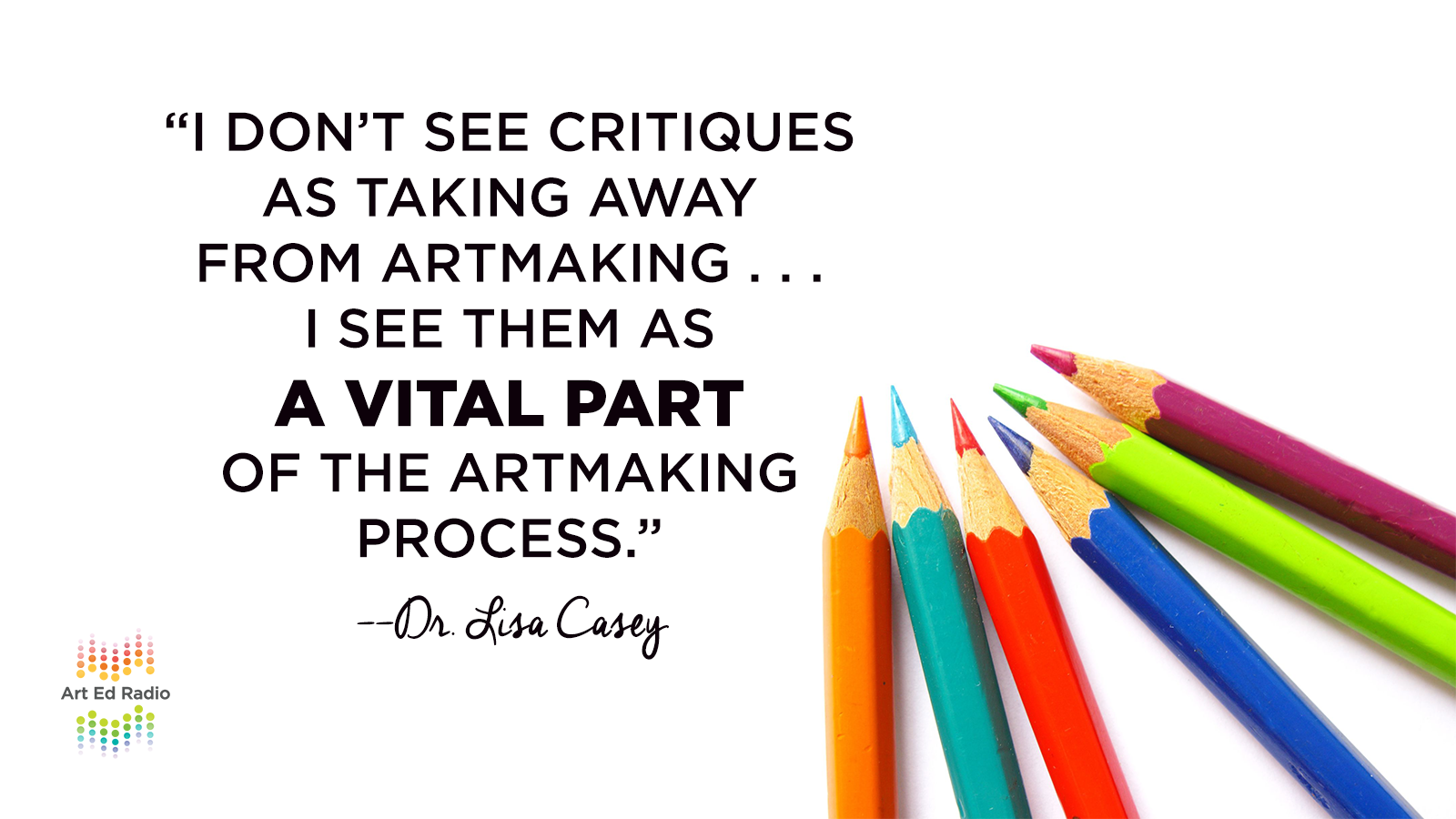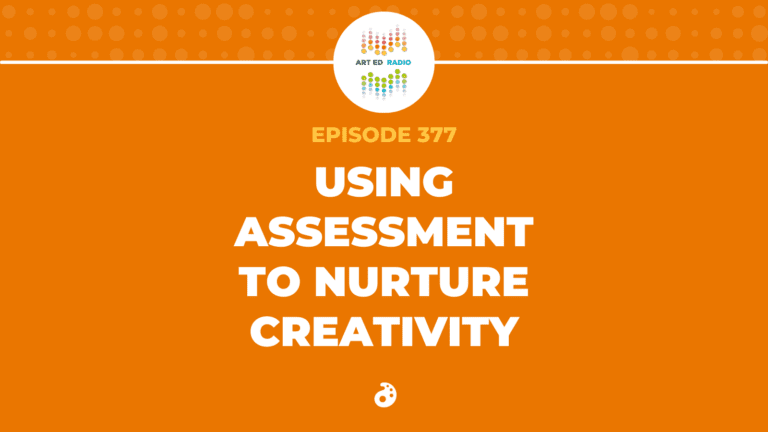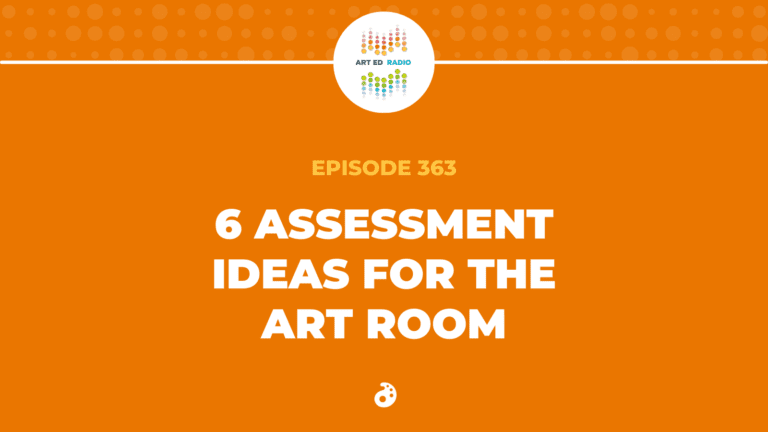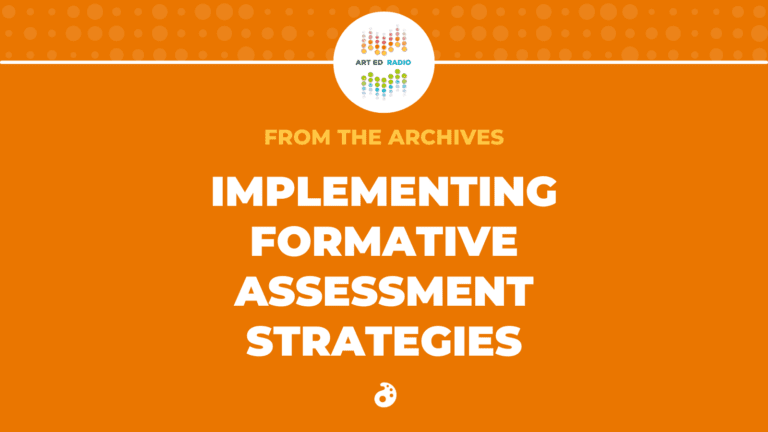It can be difficult to run successful critiques in your classroom, and find ways to get all your kids involved. But there are so many strategies to ease your kids in to these valuable and engaging learning experiences. Today, Tim is joined by Dr. Lisa Casey to talk about the power of critiques and how to get them started in your classroom. Listen as they discuss strategies for engagement, ideas for all levels of critiques, and how students grow throughout the year through participation and discussion. Full episode transcript below.
Resources and Links
- How to Improve Your Classroom Critiques
- Why You Need Critiques in Your Curriculum
- 7 Critiques You Can Use Today
- Finding Success with Critiques at Every Level (PRO)

Transcript
Tim: Welcome to Art Ed Radio, the podcast for art teachers. This show is produced by the Art of Education University and I’m your host Tim Bogatz.
We’re going to be talking today about critiques. I think this is something that not a lot of art teachers love, unfortunately. Something that not a lot of art teachers care about. But in my opinion, critiques are so, so important and I think people shy away from them because we are afraid of taking away studio time. We’re afraid of our kids not creating as much as we thought they might be able to.
So my guest today has a lot of incredible ideas about critiques and a lot of great strategies. Her name is Dr. Lisa Casey. Dr. Casey teaches in Cobb County, Georgia. We met at the NAEA conference in Boston when I attended one of her presentations. She’s talking about the importance of critiques and how, in her words, she wants to banish boring critiques. And she just kept coming with idea after idea after idea that I thought were so dynamic and so exciting and just things that your kids are going to love. So I invited her to come on the podcast and luckily, she is here today to share a lot of her ideas.
But I also want to bring up something else, just related in general to critiques. We talked about them on an episode last year with Clara Lieu from RISD. And that was a great discussion, but we focused a lot on the why with that discussion, the why we want to do critiques, and not as much on the how. And that talk was just more about why we need to get away from that mindset where we hate critiques and hate sitting in front of 20 or 30 kids that just don’t want to talk. And the whole experience that just leaves a bad taste in our mouth. So I hope that discussion worked. I hope we’ve gotten to the point where we see the importance and the value of critiques. And I think that we have been able to establish that at this point. So I want to talk to Dr. Casey more about the how. We’ll touch a little on why, but she has so many great ideas on how to get kids involved. How to make your critiques interesting and how to make your critiques worthwhile. So we’ll definitely cover that today.
But before we get to the interview, I want to talk about the Art Ed Now conference. A few weeks back, we announced the feature presenter, Ron Clark. You heard him last week on the podcast and now you know firsthand how amazing and how inspiring he can be. So you’ll love hearing from him at the conference as he talks about his career in education, the passion he has for working with his students and a little bit behind the scenes as far as what it was like for him founding the Ron Clark Academy. So like I said, it’ll be exciting. It’ll be an inspirational talk and you will not want to miss it. So you can find out more about the conference and reserve your spot at artednow.com. And of course everyone is always asking about the swag boxes. And we actually, because they’re so popular, we got more this year. But they are still running out. So go get registered. Make sure you do it soon. And finally, let me go ahead and bring on Dr. Lisa Casey so we can get started discussing critiques.
All right. And joining me now is Lisa Casey. Lisa, how are you today?
Lisa: I’m doing great.
Tim: Good, good. And thank you for coming on to talk critiques. I know it’s something that you’re passionate about, that you’re excited about. And my first question for you, the big question is, more than anything, why do you believe in critiques so much? For me, I love critiques as well, but you hear so many complaints from teachers about how they take time away from art making, they’re difficult to implement. It can be really hard to engage your kids, but for you, what makes it worth it? Why do you love doing critiques so much?
Lisa: I think I love it because I’ve seen what it can do for kids and for adults. And I think it’s really at the heart of an art experience of any type. And just to be clear, when I’m talking about critique, it’s really two things. It’s talking about your own work, but it’s also talking about work that’s created by other people, work you didn’t create. Things in and out of museums, famous work reproductions. And I think people confuse those two, and really they go hand in hand. I don’t see it as taking away from art making. I think it’s a part of art making. I think it’s a vital part. And so people do say that. They’re like, “Oh, it’ll take away so much of my class time.” It should be really an integral part of your class time.
Tim: Yeah, I would agree. And I think that during critiques or just any kind of reflection is when kids are going to learn the most, because I feel like teachers just have this drive that they need to have kids create as much as they can, get as many projects done as we can. And we don’t slow down, we don’t take time to reflect, we don’t take time to talk about those things. And so, like you said, I think that really can be just an integral part of what you’re doing. So-
And it’s almost like a mental block for teachers sometimes. It’s just like a box they have to check. And it doesn’t really have to be that.
Tim: Yeah. And there’s so many ways to make things more meaningful, not just, like you said, a box you need to check or something that you feel like you have to do. But you can actually make them engaging and fun and meaningful. So kind of in that vein, let me ask you, how do you get started with critiques for your students? how do you make sure that it’s going to be an experience that is valuable, that is meaningful for them?
Lisa: Well, I think it has to be something that you do almost daily. It just has to be such a part of the routine. I hate to see when critiques are just like a separate, like, “All right, we’re going to have critique day.” And everybody kind of glazes over. And daily critiques don’t have to be a formal sit down. It’s entrance and exit questions. It’s getting kids to title things or just a quick response, doing a little pop up in the middle of class. And just getting them more comfortable. And every time they talk about it, they get a little more comfortable, a little more confident. And it might take 15 minutes, it might take 15 seconds. But all of that time is valuable.
And to keep it valuable, you’ve got to keep it light and fun. And I keep it light and front on the outside, but on the backend I’m really selective about the images I choose and the activities that we do. I try and expose them to work that they’re not familiar with. And it just kind of increases their comfort level. Like they already know they don’t have to have something profound to say. But just to keep it to where, even if it’s images they aren’t familiar with, they know that I’m also learning with them and I think that helps them be more willing to share.
Tim: Yeah, I think so. And like you said, I think as long as kids are comfortable with it, that comes across in a couple of different ways. Number one, they know that it’s kind of a regular part of the routine, like you said, that raises the comfort level. And then secondly, when they do feel comfortable like that, they’re more willing to share, they’re more willing to be a part of those discussions. And I think that’s something that’s really valuable. And you mentioned a couple of strategies. I want to get to those in just a second, but before we do that, can I ask you just what are students’ reactions when you’re first teaching them about critiques or showing them this is what we’re going to do in my classroom. Are they curious about what you’re doing? Are they apprehensive? Are they excited? Maybe a little bit of each of those?
Lisa: Oh, a little bit of each. I mean, there’s a wide mix. And that’s with kids and adults. I mean, there’s always going to be people that love to talk and people who are terrified. And there’s everything in between. And honestly, some kids don’t want to participate, but I think that originates from fear. They don’t have the correct vocabulary, they don’t know really what you’re expecting them to say. And so I think that’s where their lack of participation comes from. So I try and have a lot of strategies where to meet folks where they are and get them where I want them to be.
Tim: Yeah. And I think that’s a really good point. And again, it goes back to when people are scared or maybe apprehensive, don’t want to talk, and we kind of reinforce that sometimes when you have critique day like once every two weeks. But like you said-
Lisa: Yeah, if you’re sitting in that circle and all eyes are on you, you better have something big to say. And I don’t like that feeling either.
Tim: Yeah. So let me ask you though, how do we get away from that? I know you have a ton of different critiques that you use in your classroom, a lot of different strategies. Can you maybe talk about some of your favorites, things that are good to engage kids or some of your just favorite types of critiques or favorite types of discussions that you like to do?
Lisa: Yeah. My critiques really fall really into three categories. There’s writing, there’s assigning roles, and there’s playing games. And really the tips, no matter what you decide to do, with what type of critique you do, I do have some top tips. So my first top tip is don’t start with Feldman. It’s too big. All our teachers know the critical method. Do kids need to know it? Sure. But it’s too much. It’s too big of a jump. They don’t have the vocabulary and the confidence and the strength to… It’s a stretch to get somebody to interpret and judge something. So my tip there is to put away the Pinterest charts in the worksheets that ask kids to write and hit on all of his points. It’s just, it’s too soon. You’ll get there, but don’t start there. You’re going to lose half of them.
And then the other thing I would tell people is to remember to keep it about the work. Especially when you’re talking about their work, it’s so personal to them. So keep it focused on the work and not about them personally, because they are going to hear the personal parts. And it’s just a shift in language. Like instead of saying, “You didn’t shade that dark enough.” You can just shift it to say if there was stronger contrast in this part of this painting, this will happen. And so it just changes the shift from them to the work. And then you also have to change your language. I find myself even walking around going, “Oh, that’s really nice. I like that.” And what I should be saying is what I want to hear back from them. Like, how that line moves me through the painting or whatever it is, whatever elements I want them to be able to talk about, I need to get in a habit of talking about it.
Tim: Yeah, I think that modeling is really important and like you said, just getting into that habit yourself is something that’s going to rub off on your kids. But I want to back up to something you said just before that. You were talking about how when you are talking to kids, you don’t want to make it personal, you don’t want to make it about them. And so I guess, would you recommend starting off with critiques from famous artists or critiques of outside artwork before you actually start talking about kids’ own artwork? Is that a good way to kind of open the gate of let them dip their toes in the water.
Lisa: Just to start it? I do. Right, because I want them to understand that really we’re not just about improving what we’re working on. It’s really about having an experience with a piece of art. And so I think if you get them just in short little spurts talking about artwork that they haven’t created, it helps them to understand that we don’t have to like everything, even if it’s in a book or even if it’s in a museum. And, so I do think that’s super important to not start with their own work. Get them accustomed to something else. Even starting with another class. They’re eager to talk about kids that aren’t in their presence and aren’t their friends sitting beside of them. So start with another group of kids, even when you start to practice how you would critique something effectively.
Tim: Yeah. That’s a really good suggestion. I like the idea of bringing in work from another class because it’s relevant to them. It may even be a similar or the same project that they’re working on right then. Then it allows them to talk about that. But there’s still a disconnect there where, like you said-
Lisa: Right. They can talk a little more freely when they’re not worried about hurting someone’s feelings or… And sometimes it’s good to limit what they can say. I think a lot of times teachers put kids out there and they’re like, “All right, tell me about your artwork.” And it’s just this limitless… They may not say anything and they may take 20 minutes to do that. But if you limit them, like if you say, “All right, tell me about this, but you can only use five words.” And then they start to get really selective about those five words. Or, “We’re only going to use words that start with W.” Then they really have to focus on what they’re about to tell you.
Tim: Yeah, that’s a really good idea. Because when you talked about limiting things, I know my discussions in my classroom are always… We would focus on something specific. Like if I wanted to limit stuff, then I’d say, “Hey, we’re going to talk about the use of line in this painting. We’re going to talk about using color in this drawing.” But man, taking it to the, “You can also use words that start with W.” That’s a whole new level, so I like that.
Lisa: And not everyone has to have a turn. You don’t have to do 27 of them in one day. Let’s talk about three of them today, and then we’ll circle back around. Because by the time you get to the 25th, nobody’s listening.
Tim: Yeah, that’s very true. Well, and especially if you’re taking turns going around the room, then kids are just sitting there dreading when they’re going to get called on and not paying attention to anything else. Okay, so let’s dive into that. Go ahead. Go ahead.
Lisa: Oh, I was going to say in that regard, when you’re talking about just going around the circle, you can change up how you ask them things. Like, if you put topics, center of interest or whatever it is you want them to say, the subject matter, you can put it on popsicle sticks or ping pong balls and throw it at them or have them draw it out of a hat. So it’s more random and they’re like, “Oh, well, I wasn’t going to talk about this. But since you asked.” And it lightens it up a little bit and then it kind of moves it along too.
Tim: Yeah. Okay. So many good suggestions. I’m loving all of this. I wanted to ask you too, just kind of about logistics. If you had suggestions for people who are thinking about trying some critiques with their kids, like how often would you recommend they do it in class? How long do you think it should take? What should people expect when they’re first trying out some of these ideas that you’re talking about?
Lisa: What does it look like? So I think a good way to start, just like at the beginning of the semester, is to get out all of your reproductions and all of your visuals in your classroom and then set up some categories and have the kids sort them, either by landscape, portrait, subject. And it allows them to have kind of a one on one conversation with a partner or friend that they don’t have the focus on them from the whole class, but they do have to discern certain categories and qualities of work. And then as you go along, you can always up the ante on that a little bit and changed the categories to elements and principles or to adjectives and emotions or however you want to have them sort it. But it kind of allows them to kind of privately ease into how would I talk about this piece? And so that’s really where I would start.
And then beyond that, I would just keep it casual, keep it small. And when you’re first trying, I think you’ll be surprised at how excited kids are to tell you what they think of something, and that you genuinely are excited about what they think about it. And I think that that kind of helps them buy in. And then moving forward from that, there’s all sorts of activities that you can do to keep it interesting and to keep it meaningful.
Tim: Yeah. I was just going to add on, one thing that I like to do is just a comparison piece, is like just put any two works up next to each other and just have kids say which one of these do you like better and why? And it’s a real easy way for them to, like you said, just kind of ease into things. And I think that’s a simple way to do that too. So-
Lisa: Yeah, that’s a great idea. Just to put two images up in and think of all the ways that it could be connected in some random way.
Tim: And it also tells you what kids respond to. Like, oh, this kid loves those bright bold colors, or this kid loves to see portraits, or this kid loves abstract stuff. And just seeing those different ideas is a way for them to get excited and get passionate about some things that they’re seeing. I wanted to ask you though too, you talked about how things kind of develop, how you can go from one place to another. So I guess I’m just curious about how your critiques develop over the course of the semester or the course of the year. Like do your students continue to improve, continue to learn? What is the difference between what your discussions and critiques look like at the beginning and what they may look like at the end?
Lisa: I think one of the biggest differences is kids ask me about it. Like if I start to slack off, they’ll say like, “Aren’t we titling this? You didn’t even ask me what I just did. And so they buy in and start to hold me accountable for, “You’re just going to tell me that’s nice. What elements or principals are we talking about?” And so, I think I’m always surprised at how along the way they pick up on what we’ve discussed. And they gain that confidence and they know that what they feel about a piece of artwork matters. And their writing for sure gets stronger. I mean, we have different writing activities that we do and that gets a lot stronger. And the games and stuff get a little more heated because they’re ready.
Tim: Yeah, they’re more passionate. They’re ready to go.
Lisa: They’re passionate about it, absolutely.
Tim: Okay. So, okay, I’m going to hit you up for one more idea before we bring this to a close. With writing activities, for people who want to bring more writing in, what would be a couple of simple ways for them to do that with their students?
Lisa: I think one of my favorite ways, even if you’re afraid of writing, this is so simple. It works great with photography and really any kind of storytelling work, is to do a quick I am poem. Give them 10 lines. They all start with I am. They take on a persona of somebody in the photo and right at that moment that the photo was taken, what is that person feeling? And then they write down those 10 feelings. And then as they read them, the class tries to determine who they are. And that really is something quick, it’s effective, and it allows them to really jump into that work and put themselves in somebody else’s shoes.
Another one that is really good for kids who are a little apprehensive maybe about writing, is to do a sound collaborative. Put up a work, and then as a class come up with a word bank of sounds that you hear in this image. And then, say you come up with 10 sounds, and then you require them to use six of them in a descriptive paragraph. It takes a lot of pressure off because they’re like, “Well, this isn’t my word, but I was forced to use it.” And their their sentences become really rich and descriptive. And then when they read that out, their writing is so much better than they even thought it could be. And again, that just builds that confidence of like, “Oh yeah, I can talk about this.”
And then I guess the other big activity that I love to do with kids is using adjectives and emotions. And I’ll have a word bank all on cards, lay all of those out, put an image up, and they work in teams to come up with, which word best embodies that piece. And then they have to convince me that their word is better than someone else’s. And that increases their debate skills. And they’re really diving deep into that painting to really look and see like, well, how does this make us feel and what are we getting from this? And so I think those are just, they’re quick, but they’re real confidence boosters.
Tim: Yeah, they’re really good. Yeah. Simple ideas. But like you said, they build confidence. They allow kids to feel like, “Hey, I can do this.” So yeah, I think that’s exactly what we’re looking for. So Lisa, we’ll go ahead and wrap it up there, but thank you so much for giving us some time and sharing all of your incredible ideas for critiques. I really appreciate it.
Lisa: You’re welcome.
Tim: I hope you can get a few ideas from what Dr. Casey had to say today. So many great things that she listed there. So many awesome ideas and they’re all easy to implement. Just simple things that really allow your kids to get into those critiques without too much pressure or too much stress. It makes it easier for them to just kind of participate. And so just, I guess a couple of closing thoughts.
Number one, don’t be afraid to have your students take the floor. They are apprehensive about jumping in the first time, but if you can kind of scaffold that and kind of ease them into it, I think that’s really worthwhile. Secondly, make sure everyone is involved. We talked about how we want to stay away from those ideas where everybody’s just sitting in a circle taking turns talking one at a time. That’s not doing anything for anybody. So make sure that you differentiate a little bit. Make sure you give kids plenty of opportunity where everyone can be a part of the activity. Divide into groups if you need to. Design things as needed so everybody can get involved.
And then one thing that I think helps me just kind of understand the value of critiques is understanding that students value what their peers think, sometimes more than what they hear from you. What you’ve been telling them for so long sinks in a little bit more when they can hear it from somebody else. And man, let me tell you, that can be frustrating. Where like, “Oh yeah, so Brian told me I needed to fit that in and just shade a little bit darker.” And you’re pulling your hair out going, “That’s what I’ve been telling you for for eight straight days.” But however we get there, let’s just appreciate that we get there. So I think letting them interact with their peers is valuable because of that reason. But it also gives kids another way to interact, another way to build community in the art room.
So if you’re still in school, I’m sorry, but you can think about some of those ideas to maybe try and finish out the year as you’re putting together portfolios, finishing final works, whatever the case may be. Or if you’re in summertime already, start thinking about how you can use these things next year. I promise you that it’s going to be worthwhile.
Art Ed Radio is produced by the Art of Education University with audio engineering from Michael Crocker. Like I said at the beginning, Ron Clark is going to be our featured presenter at Art Ed Now. He was also on the podcast last week. So go back and listen. If you haven’t done that, or heck, give it a listen again. Then go register for the conference. Make sure you get your swag box, and we will plan on seeing you on July 25th. Next week, Michael Bell will be back on the show. Awesome returning guest, and I am really looking forward to that conversation, so we’ll talk to you then.
Magazine articles and podcasts are opinions of professional education contributors and do not necessarily represent the position of the Art of Education University (AOEU) or its academic offerings. Contributors use terms in the way they are most often talked about in the scope of their educational experiences.



